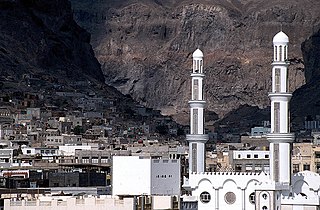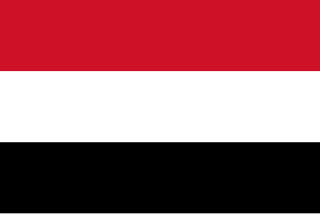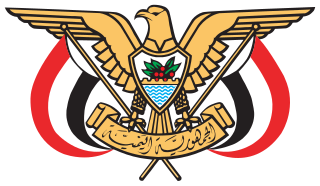
Aden is a port city located in Yemen in the southern part of the Arabian peninsula, positioned near the eastern approach to the Red Sea. It is situated approximately 170 km east of the Bab-el-Mandeb strait and north of the Gulf of Aden. With its strategic location on the coastline, Aden serves as a gateway between the Red Sea and the Arabian Sea, making it a crucial maritime hub connecting Africa, Asia, and the Middle East. As of 2023, Aden City has a population of approximately 1,080,000 residents, making it one of the largest cities in Yemen. Aden is divided into eight districts: Tawahi, Mualla, Crater, Khur Maksar, Al Mansura, Dar Sad, Sheikh Othman, and Al Buraiqa. These form today's Aden Governorate. During British Colonialism, Aden referred to the area along the north coast of the Gulf of Aden, encompassing Tawahi, Mualla, Crater, and much of Khur Maksar District. The western harbor peninsula, known as Little Aden, now falls within the Al Buraiqa District.

The national flag of Yemen was adopted on 22 May 1990—the day of the Yemeni unification. The flag of Yemen resembles the Arab Liberation Flag of 23 July 1952, introduced after the Egyptian Revolution of 1952 in which Arab nationalism was a dominant theme. The Arab Liberation Flag of 23 July 1952 served as the derivation for the flags of both North and South Yemen prior to unification by omiting the distinctive elements from the existing designs, as well as for the current flags of Egypt, Iraq, Sudan, Palestine and Syria.

The Emblem of Yemen depicts a golden eagle of Saladin with a scroll between its claws. On the scroll is written the name of the country in Arabic: الجمهورية اليمنية. The chest of the eagle contains a shield that depicts a coffee plant and the Marib Dam, with seven blue wavy stripes below. The flagstaffs on the right and left of the eagle hold the flag of Yemen.

The Yemen Arab Republic, commonly known as North Yemen or Yemen (Sanaʽa), was a country that existed from 1962 to 1990 in the northwestern part of what is now Yemen. Its capital was at Sanaa. It united with the People's Democratic Republic of Yemen on 22 May 1990 to form the current Republic of Yemen.

South Yemen, officially the People's Democratic Republic of Yemen, abbreviated to Democratic Yemen, was a state that existed from 1967 to 1990 as the only communist state in the Middle East and the Arab world. It was made up of the southern and eastern governorates of the present-day Republic of Yemen, including the island of Socotra. It was bordered by North Yemen to the north-west, Saudi Arabia to the north, and Oman to the east.

The Federation of South Arabia was a federal state under British protection in what would become South Yemen. Its capital was Aden.

South Arabia is a historical region that consists of the southern region of the Arabian Peninsula in West Asia, mainly centered in what is now the Republic of Yemen, yet it has also historically included Najran, Jizan, Al-Bahah, and 'Asir, which are presently in Saudi Arabia, and Dhofar of present-day Oman.

The Protectorate of South Arabia consisted of various states located at the southern end of the Arabian Peninsula under treaties of protection with Britain. The area of the former protectorate became part of South Yemen after the Aden Emergency and is now part of the Republic of Yemen.

The dinar was the currency of South Arabia, and then South Yemen, and the Republic of Yemen after Yemen's monetary unification on 1 July 1990. It was one of the two official currencies used in Yemen until 11 June 1996. It was subdivided into 1000 fils (فلس).
Yemen, officially the Republic of Yemen (1990–present), is a country at the southern end of the Arabian Peninsula.

The Yemeni unification took place on 22 May 1990, when the People's Democratic Republic of Yemen was united with the Yemen Arab Republic, forming the Republic of Yemen.

The Yemeni Air Force is the air force branch of the Yemeni Armed Forces. It inherited its aircraft from the former states of North and South Yemen who were supported by the United States and the Soviet Union during the Cold War, respectively. However, numbers of its aircraft can not be confirmed but serviceability of these aircraft is low, as a result of most of the air force being destroyed by airstrikes during the Saudi Arabian-led intervention in Yemen in the Yemeni Civil War.

The modern history of Yemen began with the withdrawal of the Ottoman Empire. In 1839 the British set up a protective area around the southern port of Aden and in 1918 the northern Kingdom of Yemen gained independence from the Ottoman Empire. North Yemen became a republic in 1962, but it was not until 1967 that the British Empire withdrew from what became South Yemen. In 1970, the southern government adopted a communist governmental system. The two countries were officially united as the Republic of Yemen on May 22, 1990.
This is a survey of the postage stamps and postal history of Yemen.

The National Liberation Front was a Marxist–Leninist paramilitary organization and a political party operating in the Federation of South Arabia, during the Aden Emergency. During the North Yemen Civil War, fighting spilled over into South Yemen as the British attempted to establish an autonomous colony known as the Federation of South Arabia. Following the exit of the British armed forces, the NLF seized power from its rival, the Arab nationalist Front for the Liberation of Occupied South Yemen (FLOSY) (FLOSY). In the aftermath of the Emergency, the NLF renamed itself the National Front and eventually became the main force behind the creation of the Yemeni Socialist Party, which subsequently governed the country as a single-party Marxist–Leninist state.

The First Yemenite War was a short military conflict between the Yemen Arab Republic and the People's Democratic Republic of Yemen.
The PDR Yemen Football Federation was the governing body of football in the People's Democratic Republic of Yemen, commonly known as South Yemen, and was responsible for organising the South Yemen national football team. The organisation was founded in 1940, but only became a FIFA member in 1967. In 1972, they also joined the Asian Football Confederation. The association folded in 1990 following Yemeni unification. The Yemen Football Association, considered the successor to North Yemen, subsequently took control of football in the region.

















